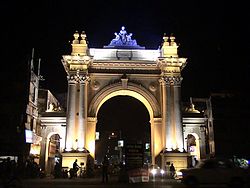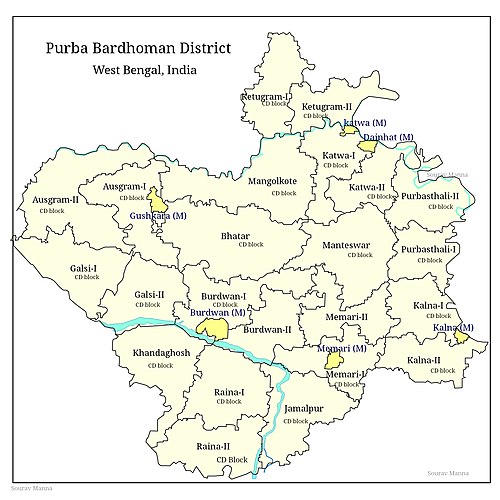Purba Bardhaman district
Purba Bardhaman district | |
|---|---|
District of West Bengal | |
 Curzon gate, Bardhaman | |
| Coordinates: 23°14′51″N 87°53′30″E / 23.2474°N 87.8916°ECoordinates: 23°14′51″N 87°53′30″E / 23.2474°N 87.8916°E | |
| Country | |
| State | West Bengal |
| Division | Burdwan |
| Headquarters | Bardhaman |
| Area | |
| • Total | 5,433 km2 (2,098 sq mi) |
| Population (2011) | |
| • Total | 4,835,532 |
| • Density | 890/km2 (2,300/sq mi) |
| Demographics | |
| • Literacy | 75.48 |
| Time zone | UTC+05:30 (IST) |
| Average annual precipitation | 1,347 |
| Website | wb |
Purba Bardhaman district is one of the districts of the Indian state of West Bengal.
History[edit]
Bardhaman district was bifurcated into two districts, Purba Bardhaman district and Paschim Bardhaman district on 7 April 2017. Paschim Bardhaman district was composed of Asansol and Durgapur subdivisions, Purba Bardhaman district was composed of Bardhaman Sadar North, Bardhaman Sadar South, Katwa and Kalna subdivisions. While Bardhaman became headquarters of Purba Bardhaman district, Asansol became headquarters of Paschim Bardhaman district.[1]
The erstwhile Bardhaman district, earlier known as Burdwan district, was formed in 1765 when the East India Company acquired the diwani of Bardhaman. Several districts were formed out of the old district – Hooghly district in 1820, and Bankura and Birbhum district in 1837. The district was subsequently divided into several subdivisions, replacing the earlier chaklas – Bud Bud in 1846, Katwa, Raniganj, Jahanabad (later renamed Arambagh) and Bardhaman Sadar in 1847, and Kalna in 1850. In 1906, Raniganj subdivision was made Asansol subdivision. The older parganas were converted to thanas (police stations). Durgapur subdivision was carved out of Asansol subdivision in 1968.[2]
See also - Bardhaman Raj
Geography[edit]
Purba Bardhaman is a flat plain land, which is part of the Indo-Gangetic Plain, with major rivers flowing through the area. The Kanksa Ketugram plain, located along the Ajay, which flows into the Bhagirathi (Bengal) is on the north and the east, the Bardhaman Plain, with the Damodar flowing on the south and south-east and the Khandaghosh Plain on the south. A small portion of the Katwa subdivision lies to the north of the Ajay, and the [[A small portion of the Katwa subdivision lies to the north of The Ajay, and a small portion of the Khandaghosh and Raina blocks lie to the south of the Damodar. While most of Purba Bardhan district is flat plain land the Ausgram area of Bardhaman Sadar North subdivision has undulating topography, similar to that of Paschim Bardhaman district.[3]
Purba Bardhaman district covers an area of 5,433 sq km.[4]
Purba Bardhaman district is bounded by the Birbhum district and Murshidabad district on the north, by the Nadia district, across the Bhagirathi (Bengal), on the east, Hooghly district and Bankura district on the south, and by the Paschim Bardhaman district on the west.[3]
Subdivisions in Purba Bardhaman district are: Bardhaman Sadar North subdivision, Bardhaman Sadar South subdivision, Kalna subdivision and Katwa subdivision.[5]
Community development blocks in Purba Bardhaman district are: Ausgram I, Ausgram II, Galsi I, Galsi II, Khandaghosh, Burdwan I, Burdwan II, Bhatar, Raina I, Raina II, Jamalpur, Memari I, Memari II, Manteswar, Mongalkote, Ketugram I, Ketugram II, Katwa I, Katwa II, Purbasthali I, Purbasthali II, Kalna I and Kalna II.[6]
Demographics[edit]
Purba Bardhaman has a population of 4,835,532. It has a literacy rate of 75.48%.[4]
Economy[edit]
In the erstwhile Bardhaman district agriculture was the pre-dominant economic activity and the main source of livelihood for the rural people. Cash crops are also grown. Irrigation facilities had contributed in a major way towards higher agricultural productivity. Amongst the districts of West Bengal, Bardhaman district had maximum irrigated land under cultivation.[7]
57.76% of the population of Purba Bardhaman district is engaged in agriculture. It is the largest producer of rice in West Bengal.[8]
Purba Bardhaman district receives an annual rainfall of 1,347 mm.[9]
Transport[edit]
Grand Trunk Road / National Highway 19 (old numbering NH 2) passes through this district.[10][11][12]
See also Category:Railway stations in Purba Bardhaman district.
Education[edit]
Purba Bardhaman district has 3,008 primary schools, 127 middle schools, 373 high schools, 245 higher secondary schools, 20 colleges and universities, and 60 professional and technical schools and colleges.[9]
The following institutions are located in Purba Bardhaman district:
- University of Burdwan was established at Bardhaman in 1960.[13]
- Burdwan Medical College and Hospital was established at Bardhaman in 1969.[14]
- University Institute of Technology, Burdwan University was established in 2000 at Bardhaman.[15][16]
- College of Agriculture, extended campus of Bidhan Chandra Krishi Viswavidyalaya was established at Nari in 2014.[17]
Note: More Information about private engineering colleges and degree colleges are available in the subdivision pages.
Healthcare[edit]
The major medical facilities in the district are:[18]
- Bardhaman Medical College and Hospital at Bardhaman with 1,181 beds
- Bardhaman Jail Hospital at Bardhaman with 35 beds.
- Bardhaman Police Hospital at Bardhaman with 44 beds.
- Bardhaman Railway Hospital at Bardhaman with 5 beds.
- Kalna Subdivisional Hospital at Kalna with 234 beds.
- Katwa Subdivisional Hospital at Katwa with 250 beds.
Note: The subdivision and community development block pages provide information about medical facilities within their jurisdiction.
References[edit]
- ↑ "The Kolkata Gazette dated 24 March 2017" (PDF). Notification. Department of Personnel and Administrative Reforms and e-Governance, Government of West Bengal. Retrieved 30 June 2023.
- ↑ "Paschim Bardhaman". History. Government of West Bengal. Retrieved 30 June 2023.
- ↑ 3.0 3.1 "Purba Bardham". Geography. Government of West Bengal. Retrieved 30 June 2023.
- ↑ 4.0 4.1 "Purba Bardhaman". About District. Government of West Bengal. Retrieved 28 June 2023.
- ↑ "Purba Bardhaman". About District -Subdivisions and Blocks. Government of West Bengal. Retrieved 1 July 2023.
- ↑ "Purba Bardhaman". Subdivisions and Blocks. Government of West Bengal. Retrieved 30 June 2023.
- ↑ "District Human Development Report: Bardhaman" (PDF). Pages 50-54. Development and Planning Department, Government of West Bengal, 2011. Archived from the original (PDF) on 14 August 2017. Retrieved 30 June 2023.
- ↑ "District-wise Crop Production in West Bengal". Purba Burdwan (Bardhaman). Agri Farming. Retrieved 30 June 2023.
- ↑ 9.0 9.1 "District Profile". Purba Bardhaman Zilla Parishad. Retrieved 30 June 2023.
- ↑ Cite error: Invalid
<ref>tag; no text was provided for refs namedmunicipality - ↑ "Paschim Bardhaman". Tourism/ How to Reach. Government of West Bengal. Retrieved 10 July 2023.
- ↑ "Rationalisation of Numbering Systems of National Highways" (PDF). New Delhi: Department of Road Transport and Highways. Archived from the original (PDF) on 1 February 2016. Retrieved 2 July 2023.
- ↑ "Burdwan University". Shiksha. Retrieved 1 July 2023.
- ↑ "Bardhaman Medical College". About – Our History. BMCH. Retrieved 1 July 2023.
- ↑ "University Institute of Technology". UIT. Retrieved 1 July 2023.
- ↑ "University Institute of Technology". College Dunia. Retrieved 1 July 2023.
- ↑ "Extended Campus of BCKV, Burdwan". BCKV. Retrieved 1 July 2023.
- ↑ "Directory of Medical Institutions: West Bengal (as on 31 March 2018" (PDF). Paschim Bardhaman, page 167. Directorate of Health Services, Government of West Bengal. Retrieved 28 June 2023.

